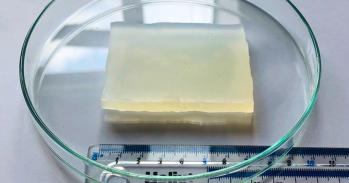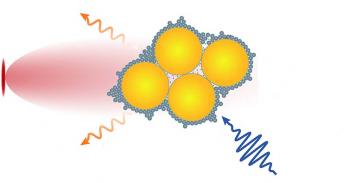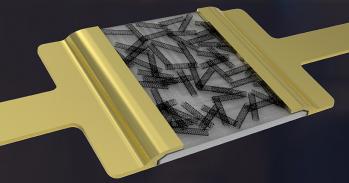
Taking their cue from the building blocks of life, Cambridge chemists are assembling polymers that move.
Taking their cue from the building blocks of life, Cambridge chemists are assembling polymers that move.
Soft nanotechnology is an emerging area of science that aims to do just this: by understanding and exploiting polymeric (and small molecule) building blocks, the goal is to form functional devices that can mimic some of the properties of biological systems.
Biological cells are among the most complicated devices imaginable. They store information, translate it into function, perform an enormous range of chemical transformations, respond to heat and light as well as mechanical and chemical stimuli, and perform physical movement. Yet none of these actions is driven by electricity or controlled by software, and the ‘devices’ are not fabricated using lithographic techniques or other engineering tools. Instead, cells rely on chemical energy and efficient chemical reactions to drive their complex machinery.
The machinery itself is principally made up of functional assemblies of building blocks, or monomers, which together form larger polymers such as DNA, RNA, proteins and cellulose. Although man-made devices are increasingly sophisticated (one can think of modern-day computers, memory devices, miniature robots, and so on), they are not even close to approaching the level of complexity observed in cells. Can lessons be learned from nature’s successes in self-organising and self-assembling building blocks into functional entities that run on chemical energy?
The softer side of nanotechnology
To design and fabricate devices that merge principles from engineering with biological design rules for cellular machinery, a step change is needed in our understanding of how soft materials are assembled and organised into functional materials. Soft nanotechnology is an emerging area of science that aims to do just this: by understanding and exploiting polymeric (and small molecule) building blocks, the goal is to form functional devices that can mimic some of the properties of biological systems. To do this, we need to understand how to synthesise these building blocks, how to assemble them and, most importantly, how to incorporate functionality.
It is clear that the building blocks used in biological systems are far too complex to synthesise de novo. Research in Professor Wilhelm Huck’s group in the Melville Laboratory for Polymer Synthesis, Department of Chemistry, is therefore aimed at exploiting the properties of synthetically accessible polymers. Synthetic polymers have been around for some time – one has only to think of plastic, nylon and polystyrene to understand how important and commonplace synthetic polymers are today. Not only are polymers inexpensive and easy to use, as it turns out they also provide remarkable flexibility in the field of soft nanotechnology.
One important aspect of the group’s research is based on the introduction of architectural order to the polymers at the nanometre scale. Essentially, it is the arrangement and confinement of individual polymers in relation to each other and to the surface that supports them that holds the key to expanding their functionality.
‘Hairy’ surfaces
A good example of novel properties arising from confinement are polymer brushes. These are best imagined as hair growing out of a surface: the polymers assemble at high density, with little space between them, and are ‘rooted’ at one end to a surface. Like real hair, the synthetic conditions can be tailored so as to make short, long, curly or very straight hair. Of course these structures are at molecular lengthscales that can be 10,000 times smaller in diameter compared with a human hair.
Polymers normally resist stretching and would prefer to form a curly carpet. It is possible to switch this polymer carpet layer between stretched (straight) and collapsed (curly) states via a wide range of physical and chemical triggers such as temperature, light, salt and pH. Not only does the transition change the properties of the polymers but it also changes the level of interactions between neighbouring chains. Crucially, this has the added effect of changing the properties of the surface, including wettability, roughness and stiffness.
Harvesting the effect of these simple movements opens up a whole new area of applications in the area of ‘nanoactuation’. By growing the polymer brushes on flexible, microfabricated cantilevers (a structure supported only at one end, like a balcony), and allowing the brushes to switch from stretched to collapsed, the cantilevers bend to relieve the surface stresses that are generated inside the polymer brush layer. If these conformational changes are used as a way of transforming chemical energy into mechanical work, then you have the basis of a ‘nanoactuator’. Work in collaboration with Professor Ulli Steiner in the Cavendish Laboratory in Cambridge is currently extending the actuation properties of polymer brushes to explore the possibility of fabricating molecular ‘conveyor belts’ based on the directional movement of polymer brushes. Potential applications for these types of surface modifications are in microfluidics, where valves actuated by polymer coatings could be used in self-regulating fluidic devices.
In addition to industrial applications, such as protective coatings and polymer photovoltaic devices, other applications are to be found in the world of biology, especially in the area of ultrasensitive detection systems for viruses and bacteria. And, in an interesting twist, actuation in polymer brushes driven by chemical signals (instead of electrical signals) brings us much closer to understanding actuating principles found in nature. For example, in the pond-dwelling protozoan Vorticella, the hair-like stalk that anchors it is able to coil and uncoil like a spring and, similar to the situation with polymer brushes, the rapid contraction is a result of forces restoring a collapsed state between neighbouring polymeric building blocks.
Tailored soft materials
Ultimately, the group hopes to shrink dimensions much further and really operate at the lengthscales of biological machinery inside living cells. Some of the current work is geared towards arranging brushes into nanoscale (35 nm) patterns and studying the transition from the collective behaviour of ‘infinite’ carpets to individual polymer chains. These studies are very important to provide general guidelines for the design of materials that are based on nanostructured polymers because it is far from obvious how the properties of soft materials deviate when structured or confined at small lengthscales. The group’s results strongly indicate that many of the properties change considerably because, unlike bulk materials, the individual chains are all in a slightly different environment.
To exploit soft materials to their full potential, it has become increasingly important to determine how these materials can be interfaced with micro- and nanofabricated electronic devices. But future applications of soft nanotechnology are not necessarily all at a very small scale. For example, the next generation of materials for tissue engineering will require ‘smart’ scaffolds that have the right mechanical and chemical properties, combined with biocompatibility, surface chemistry and degradability. The group is currently working on nanocomposites formed from blending polymers and inorganic particles with the right surface coatings and has identified several that form excellent scaffolds for the growth of stem cells that differentiate into bone cells.
The lessons learned from model studies on polymer brushes provide us with new tools to finely tailor the properties of materials. In the future, we will see many more soft materials that are engineered at the nanometre level to provide a level of complexity and functionality that makes these materials interact with biological matter in a completely new way.
For more information, please contact the author Professor Wilhelm Huck (wtsh2@cam.ac.uk)
at the Melville Laboratory for Polymer Synthesis, Department of Chemistry.
This work is licensed under a Creative Commons Licence. If you use this content on your site please link back to this page.





